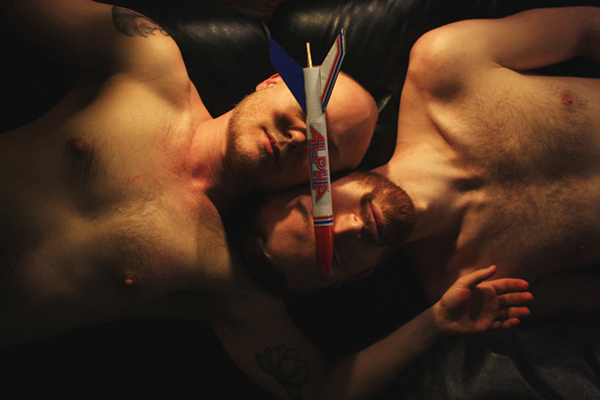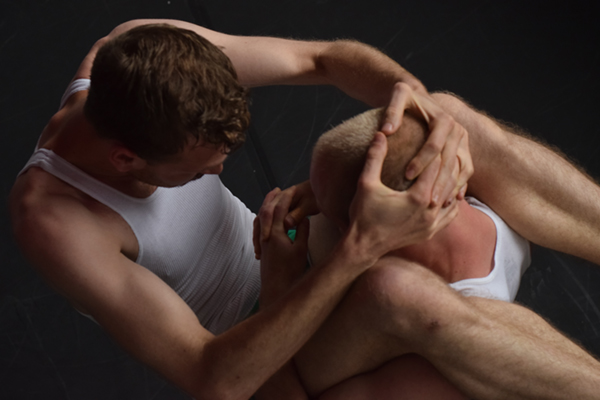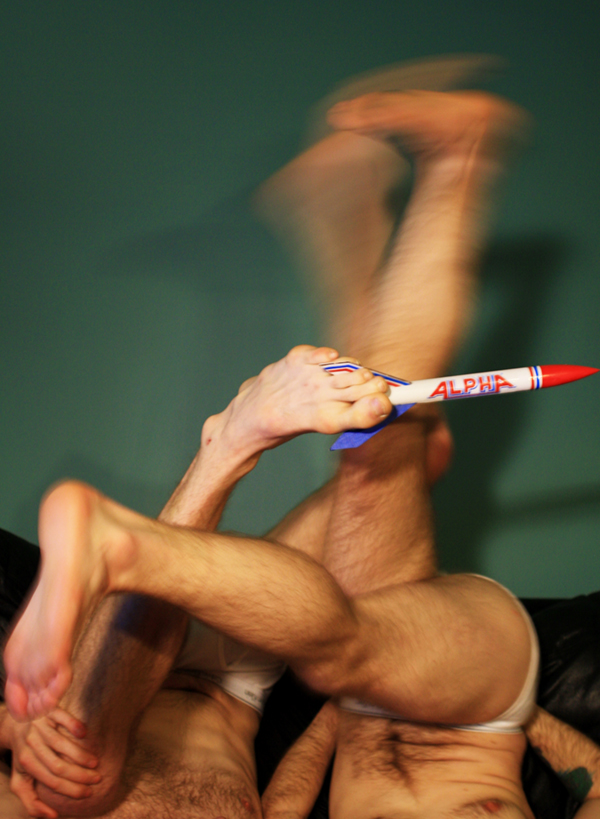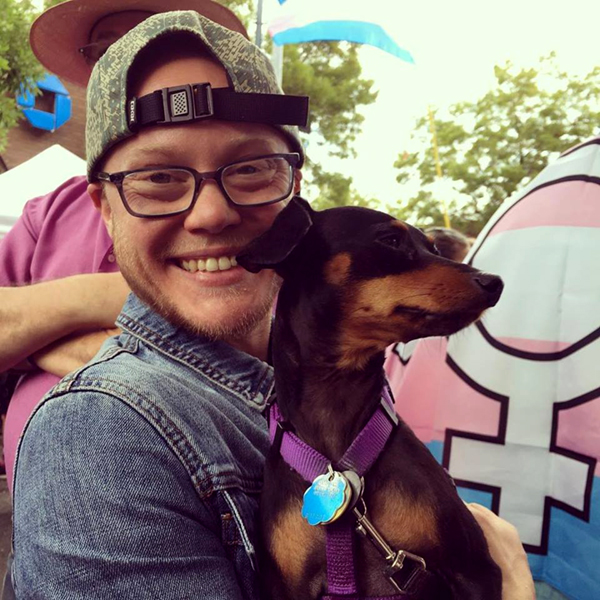Choreographing His Trans Experience
An Interview with Elby Brosch
BY EMMALY WIEDERHOLT
Elby Brosch is a trans masculine dancer and choreographer based in Seattle. Here, he shares his history and why making dances from a trans masculine perspective is important to him, as well as his observations on the different ways men, women and trans people are able to get opportunities in the dance field.
Photo by Dillon Webster
~~
Can you tell me a little about your history in dance and choreography?
I started dancing when I was 10. My mom put me in ballet classes. My family had recently moved to a new town, so ballet was a way to make friends through an extracurricular activity. I was a little resistant to it at first, but I ended up really loving ballet. I loved the structure. I was a very shy child, so having an activity where there was no talking really helped me. Ballet ended up being therapeutic for me as a teenager. Both of my parents got cancer and my dad died. I had a hard time processing my grief. Because it was so structured, ballet class became this solid and consistent thing in my life and a safe place where I could be connected with my body. I fell in love with dance and became dependent on it during that time.
Toward the end of high school, I was trying to figure out what I wanted to go to college for. I knew I couldn’t stop dancing. I ended up going to the University of Illinois. I looked into that school because my dad went there. He actually got a master’s in composition and used to compose for the dance department in the late 60s/early 70s. I just wanted to visit where he went, but I ended up really liking the dance department. They have a lot of incredible professors.
That’s where I started choreographing. Before college, I had barely been exposed to modern dance, but I fell in love with it in college and I had the opportunity to start making work as well. As questions of identity started to come up for me, my creative voice became more important. I started exploring and asking questions, as well as sharing my questions and getting answers through the sharing.
I moved to Seattle after college and waited awhile to start choreographing. It took me some time to get my bearings and figure out how I wanted to be a choreographer.
How would you describe your work to someone unfamiliar with it?
The work I make is all centered around identity. It’s very dynamic and abstract. There are dancey moments but also lots of stillness. I’m interested in drama and irony, and I’m excited by pushing limits.
Photo by Liz Houlton
I’m also inspired a lot by other media. Drag is my favorite art form. It’s not one I personally participate in, but I’m so inspired by its ability to make strong references and flip them on their head. For example, there’s the use of bold music choices. In any drag show, you’re going to hear a pop song you’ve heard a million times, but you’re going to experience it in a completely new way. I love that ability to take memories and references and add something new to them.
As far as ballet, it’s locked into my body. I wouldn’t call my choreography balletic, but it’s clear that I have that training. I try to throw it out as much as possible, but I’m so thankful for the athletic tools that ballet has given me.
Looking at your work history, are there certain themes or issues you feel are particularly important to you to keep tackling and addressing?
I have a fairly unique perspective being a trans masculine person socialized as female and passing as male. I have the ability to see all the ways society has treated me through my transition. I’m interested in sharing, deconstructing and exploring that experience, as well as inviting people in. I do struggle with feeling othered sometimes, but whenever I describe my experience to people, I find that there are more ways that we’re relatable than different. Everybody has felt othered or excluded. Everybody struggles with loving their body. If I can share the things that feel alienating to me and invite people in, I can hopefully let people feel more connected and start to understand the trans experience. Hatred comes from not understanding and fear of the unknown. If I can get people to see me as relatable, then hopefully that’ll make trans people in general more relatable.
Is it important to you that your work is viewed through the lens of being trans masculine?
In the work I’m making now, it’s important for people to know. This issue came up in my last work. I did a duet with a cis man and we were wearing nothing but tighty whitey underwear. My lighting designer thought people might not know I’m trans and asked if it mattered that they know. I responded that I was almost naked – how could they not know? The big question became: Does it matter that they know? I definitely desire people to know. It’s part of my mission statement and it’s in my bio. At the same time, the beauty of dance, especially abstract dance, is that every audience member gets something different out of the experience. That’s something that’s always been interesting and exciting to me about dance, so I also embrace that. If people see a bunch of swoopy movement, then that’s great. But my artistic statement is definitely political about sharing my experience as a trans person.
Photo by Dillon Webster
During my choreographic process, I try to find ways to let people in through moments that are clear doorways. I never want to make something that’s explicit, but I need to let people in enough so we can be on the same journey. I’m always interested in addressing the problem of making sure everybody is on board.
However, when I’m dancing for other people, I’d be glad to not have my being trans be an issue, especially if the choreographer is making work that’s not about gender. I’d like to be able to show up to an audition and have my gender not matter. I’d like the fact that my body doesn’t look exactly like every other cis male to not matter. Overall, I’d like to see less gender rigidity in terms of casting.
Looking at language, are there ways people have discussed your work – either in press, social media, or in person – that you feel carry problematic implications or assumptions?
It’s something I feel nervous about but I’ve been lucky enough to not run into. I’m very much in the beginning of my choreographic career, and I haven’t had a lot of articles written about me. The articles I have had written about me, the authors know me, so I don’t have strangers writing about me. That helps, because they know how to talk about me. I think I’ve been very lucky. It’s been the same experience with performance talkbacks; they’ve been led by people who know me.
With regards to transgender representation in dance, have you noticed some shifts in the field? What are some areas you’d like to see improved?
It is shifting for the better. When I first moved to Seattle six years ago, I didn’t see a lot of other trans people around. Specifically at Velocity Dance Center, the staff was all very welcoming and interested in learning how to be a more inclusive. I’ve watched them add more inclusive language on their audience survey forms, and they now have gender neutral restrooms. I’ve started to see more trans people come through Velocity. That’s been exciting to see. It’s only one place, but it’s a place I go and love.
As silly as it sounds, it’s important to have gender neutral restrooms, and I’m seeing that more and more. Just being able to pee comfortably is huge, and also an indicator that a place is attempting to be safe.
Since you were socialized female and pass as male, I’m curious your thoughts on gender inequality in dance?
It’s so apparent. I definitely get more attention now that I’m being perceived as male. I think male privilege in the dance world is still so rampant. I’ve seen cis men move to Seattle and all the sudden be cast in everything or get several choreographic opportunities at once. That’s not been my personal experience because there are ways in which I still don’t have access because I’m trans and I don’t have a traditional-looking body. But in general, being perceived as male, I get listened to a lot more than when I was perceived as female. It’s that same old stereotype where women are supposed to be quiet, and everything men say is bold. If people are going to listen to me, I think it’s my responsibility to speak up for those who aren’t being listened to.
What are some ways you’d like to expand your work in the future?
I’ve presented my work in festival format a lot and made several 20-minute pieces. Right now, I’m beginning to work on my first evening-length piece. I’m super excited! I’m going to be producing it with the help of Tonya Lockyer in early 2020. I’d love to eventually tour the work as well and have the opportunity to share with other communities.
Elby with his dog, Prince, at Trans Pride; Photo by Emmett Stanfield
~~





3 Responses to “Choreographing His Trans Experience”
Thanks Sandi!
I loved the article, I was able to understand trans gender people, although I’m gay it’s hard for me. You are brave and have been able to live your dreams as we all want to.
Very glad to see this here, but even more glad to live in Seattle and get to see Elby’s work as it develops!
Comments are closed.